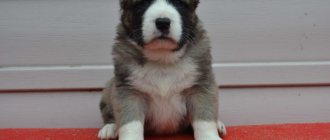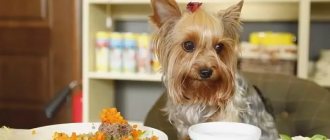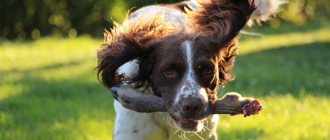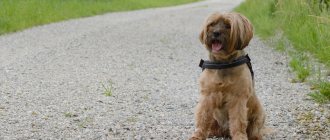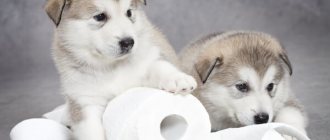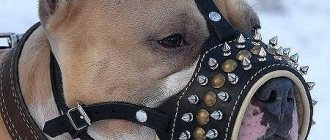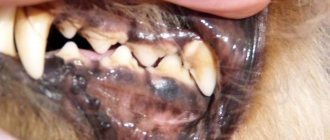It is strictly forbidden to feed your dog porridge, boiled bones and table scraps: this can be dangerous. Therefore, even before getting a pet, you need to think about what it will eat. If you are not ready to buy expensive food or make meat the basis of your diet, because... your wallet doesn’t allow it, which means you need to wait a little while buying a dog. However, the Miniature Schnauzer is not a cheap breed, so those who purchase it are able to provide good nutrition.
- About dog digestion
- Miniature Schnauzer nutrition: 3 options
- Feeding with natural food
- Miniature Schnauzer feeding rates by month
- Miniature Schnauzer food allergy
Digestion of dogs
Dogs are predators, but they are semi-carnivorous animals, because... As a result of evolution, we learned to digest and assimilate not only animal, but also plant food. That is, a dog’s diet can and should contain a plant component, but not just any one. We'll talk more about this below.
Article continues after advertisement
The dog tears the food rather than chews it, so the pieces end up in the stomach crushed just enough to be swallowed. Usually eating a portion occurs in 1-2 minutes. However, this is not a problem, because, firstly, dogs do not have enzymes in their mouths, and, secondly, the dog’s stomach is perfectly adapted to digesting fairly large pieces. But, if the pieces are too large, some dogs feel sick - these dogs need to chop the food before serving.
The stomach of dogs is highly acidic: the pH is 1-2 - much more acidic than that of humans. This means that the dog’s stomach perfectly disinfects most of the most common infections that can come from food (Escherichia coli, Salmonella spp., Clostridium perfringens, Listeria monocytogenes, Campylobacter spp. and others). In addition, a healthy stomach can digest a small amount of bones (unheated!).
The complete digestive cycle of a dog is 12-15 hours, but the exact time depends on the composition of the food and its quantity. The speed of passage of a bolus of food through the intestines is also influenced by physical and emotional stress, the physiological state of the animal and some other factors.
On average, dogs go to the toilet to relieve themselves 1-2 times a day - ideally this should happen during their morning and evening walks. Although many puppies have a bowel movement after eating rather than before, it is still best to feed your dog after a walk. This is due to the fact that most dogs are active when walking, and physical activity on a full stomach is harmful and even dangerous. As a rule, adult dogs learn to have a bowel movement outside, even though they have not yet eaten.
Standard
This standard was first published on April 18, 2007:
- General information. The dog is small in size, stocky, but without signs of dwarfism. The coat is short and harsh.
- Head. The skull is strong, somewhat elongated in length. The head is proportional to the size of the animal. Its length is half the length of the back (from the withers to the beginning of the tail). The forehead is moderately wide and flat. There is a clearly defined transition from the forehead to the muzzle. The shape of the muzzle resembles a blunt wedge. The eyebrows are bushy. The nose is quite large, always black, and the nostrils are well opened. The jaw is wide and strong. The ears are set high. Uncropped ears are of medium length, erect on cartilage. The eyes are oval-shaped, dark in color, set low and wide. The skin of the eyelids is dark and tight-fitting.
Miniature Schnauzer Standard
- Frame. The chest is moderately wide, the ribs are flat, and have an oval shape in cross section. In relation to the shoulder-scapular joints, the chest protrudes forward, somewhat convex. There is a rise in the lower part of the chest towards the abdomen. The belly is tucked in. The dog looks compact, stocky, somewhat cuboid (the length is almost equal to the height at the withers). The back is sloping and short. The topline forms a slight curve.
- Limbs. When viewing the animal from the front, they are straight and set wide apart. They have strong bones and lean, prominent muscles. Elbows and shoulders fit well to the body. The forearms are straight and well developed. The paws are arched, straight, reminiscent of a cat. The claws are strong and dark in color. The pads are dense.
- Coat. The undercoat is soft, dense, and short. The outer coat is hard and does not fit tightly. A characteristic feature of the breed is bushy eyebrows that shade the eyes, as well as thick outgrowths of fur that resemble a mustache and beard. The natural coat covering the limbs is longer than that covering the body. Shedding is not pronounced.
- The height at the withers of the pet should be 30-36 cm. For males it is preferable at the upper border, for females at the lower border. Even slight deviations in growth are a defect for this breed.
The height at the withers of the pet should be 30-36 cm
Types of feeding
Many people feed their dogs homemade food from the table and cereals, but these options are not even considered by nutritionists, because... they are wrong. There are three options for feeding dogs of any breed (not just schnauzers), recognized by dog handlers and veterinarians.
- natural food (meat, vegetables, supplements);
- ready-made factory feed;
- mixed nutrition: natural products + feed.
Each of the three options has its pros and cons. Natural food is the healthiest, species-typical type of nutrition: dogs on the right natural food are healthier than their counterparts on food. However, not everyone is able to master the basics of such nutrition, and many do not have enough time. Then ready-made food comes to the rescue.
Many owners think that if they choose factory-made food, the problem of balanced nutrition has already been solved by the manufacturer. In fact, ready-made food is a solution for those who are very busy, but it is not the best nutrition, and stories about the ideal balance of food are nothing more than a marketing ploy by sellers.
Example: a 4-year-old dog eats premium dry food. A set of diagnoses that appeared, including as a result of nutrition: toxic liver damage from an excess of vitamin D (the manufacturer of one of the most popular feeds in the world was mistaken for a long time and added toxic doses of the vitamin), cholangitis, liver failure, refusal to eat due to these diseases, excess weight, cystitis. Of course, it is not only poor nutrition that leads to such problems, but nutrition is one of the pillars of health.
Article continues after advertisement
You need to understand that expensive food does not guarantee the absence of health problems and does not guarantee a balanced diet. The only difference is that factory food is better balanced than food offered by an owner who has no idea about dog feeding standards. But food cannot in any way be better than the food offered to his pet by an owner who has studied the basics of natural feeding.
Why are veterinarians increasingly prescribing food for dogs, especially if they already have some kind of disease? There are several reasons. Firstly, it is easier than showing people the basics of proper natural feeding. Secondly, many veterinarians themselves do not know these basics thoroughly, and therefore give harmful advice or generally shy away from giving advice.
Thirdly, many veterinary clinics enter into agreements with food manufacturers and undertake to impose them on patients. Fourthly, some foods, especially medicinal ones, contain substances that mask the manifestations of chronic diseases, which is why it seems that the pathology has receded as a result of eating the food. Fifthly, most veterinarians, even at the dawn of their careers, become familiar with the consequences of improperly eating bones and eating from the table, after which they consider it necessary to warn owners against such feeding, because By natural, ordinary people often mean food from the table.
In general, there are plenty of reasons to recommend the food. Not all reasons, as you can see, indicate incompetence or dishonesty of the veterinarian. But this does not mean that when you hear a recommendation to switch to food, you should immediately implement it. There are a sufficient number of professionals who can create a natural menu for your pet.
MEMBER OF THE COMMISSION ON STANDARDS OF THE RUSSIAN CYNOLOGICAL FEDERATION IRINA SHVETS: “Premature physical development of dogs is largely a problem with industrial feed. Many dry foods are made according to the animal husbandry principle: to quickly remove growth and weight, which accelerates the development of the body, but also accelerates its aging. For example, in my opinion, dysplasia is largely a feeding problem. In many ways, it is associated with industrial feeds and the forcing of “saleable appearance” in puppies. Why fatten a dog like this? Excess weight puts extra stress on unformed bones and ligaments, and the proper formation of joints is disrupted. And, if we delve a little deeper into physiology, we learn that in order for cartilage and ligaments to form correctly, collagen is necessary, which is formed when there is sufficient intake of vitamin C in the body. Vitamin C is produced in the body of predators only from complete protein of animal origin. And this is raw meat. The chain is simple, but no one wants to think about it. Yes, and aggressive advertising of dry food and anti-advertising of natural feeding do their job. It is easier for owners and breeders to give dry food. Previously, dogs did not know what dry food was, and lived a long time, jumped two-meter fences, because there were no problems with their joints. And there weren’t so many problems with gastric volvulus.”
Summit Three Meat Reduced Calorie Recipe
"Drying" Summit Three Meat Reduced Calorie Recipe is recommended for adults and older dogs, as well as pets suffering from excess weight. The product is well suited as a main diet option.
See where it's cheapest >>>
Summit Three Meat Reduced Calorie Recipe
The composition of the feed is represented by three types of meat components at once - salmon, young lamb, chicken. Such a mix, in combination with other components, gives the food an original taste that the livestock really likes.
Natural food for miniature schnauzer
A miniature schnauzer will be happy and healthy if offered natural feeding. Feeding puppies is different from feeding adult dogs. However, the basic set of ingredients is the same.
Authorized Products
There is a list of permitted and acceptable foods for dogs and a list of mandatory ones. Let's consider both.
Meat is the most important product. The meat of rabbit, chicken, turkey and other birds is considered the most dietary and easiest to digest. Beef is more difficult to digest, but it can also be included in the diet. Lean parts of pork are suitable as one of the components: it is especially effective for feeding individuals with underweight. True, many experts do not recommend pork due to the fact that it can be infected with the Aujeszky's virus, which is fatal to dogs. Therefore, owners either give pork to the dog at their own peril and risk, or do not give it at all. Horse meat, venison, bear meat, goose without fat are good meats that can be added to your diet or even made the basis if it is problematic to diversify the menu with other types of meat in your locality.
Meat must be selected carefully: only at certified points, while sniffing it and inspecting it for the presence of worms and strange inclusions, as well as normal color. Do not buy meat from places that sell animal products - buy only from shelves for people.
Offal. In addition to meat, the dog’s diet should include by-products - hearts, stomachs, testes, liver (up to 5% of the diet), spleen (up to 5% of the diet instead of the liver, since these two products weaken), kidneys, lungs (you shouldn’t get carried away with them , because they have low energy value), rumen.
Bones. The meat and bone component is a source of calcium, collagen, glucosamine and chondroitin, necessary for the formation of bone and cartilage tissue. If your dog has trouble digesting bones or you are afraid to include them in their diet, you may want to consider alternative sources of calcium. You can’t live without sources of calcium at all!
Article continues after advertisement
If there are bones in the diet, then they must be raw (pre-frozen in the freezer for at least 3 days, and then naturally warmed to room temperature), always with meat grown on them, not tubular. Chicken necks, heads and frames will work. You can only give bones to a dog according to certain rules, and not all dogs are allowed bones.
Fish is not a mandatory part of the menu, but it is healthy and recommended. Fatty fish (mackerel, salmon, sardine) are especially beneficial. Sea fish can be served raw frozen or baked/boiled, river fish - only boiled and baked, because she is always affected by helminths.
Vegetables are primarily a source of fiber for dogs, helping to form more regular stools and maintain intestinal microflora. Unlike a cat, a dog must have vegetables in its diet. Among them, it is worth highlighting cucumbers, carrots, cabbage, and zucchini. But dogs are not allowed to eat eggplants and avocados. The proportion of the plant component should be from 5% to 20%. If you give more than 25% of the plant component, then a sharp alkalization of the urine will occur, which threatens the development of urolithiasis.
Fruits. You should not get carried away with too sweet fruits and stone fruits. The former contain a lot of fructose, the latter can lead to intestinal upset. Apples, pears, apricots, blackberries, strawberries, raspberries, cranberries, blueberries, and blueberries are good for dogs. But grapes cause poisoning (not for everyone, but it’s better not to check). Bananas and peaches are too sweet foods for dogs and should not be given to them on a regular basis.
Dairy in a dog's diet is a controversial topic. Dogs older than 3 months are sick from milk because... they no longer digest lactose. Low-fat fermented milk (cottage cheese up to 5%, kefir, fermented baked milk, cheese) are permitted products. However, you should be careful with kefir, because... it often causes bloating, and in general it is quite a heavy food.
Cheese is a fatty food, so even small pieces make many dogs sick. That is, you shouldn’t get carried away with cheese, and it’s better to use other natural treats as daily feeding during training. Please note that some dogs are so lactose intolerant that even a small piece of cheese will cause diarrhea for more than a day.
Eggs. Over chicken eggs, which are heavy food and often cause negative reactions (many dogs tear them out), it is better to prefer quail eggs - light and very healthy food. We serve it raw, before washing it.
Greenery. Parsley, dill, basil, dandelion leaves, raspberries, currants, etc. Can be added to your dog's diet in small quantities. Onions and garlic are prohibited.
EXPERT COMMENT: VETERINARY DIETITIST RUMIA FEYZULOVA
Article continues after advertisement
“There is no need to try to give all the products on one day or to necessarily put them in a mixture. The balance is achieved over a period of 1-2 months. It is perfectly acceptable to feed chicken mix for, say, a week or two, and then make beef mix. Some weeks you can give dairy products and fish twice, but others don’t. The same goes for herbal ingredients. It is optimal to use seasonal vegetables and fruits. Try to use a variety of foods, this will make your diet rich and valuable.”
What foods should a dog not eat?
Prohibited foods for dogs include:
- grapes (highly likely to cause poisoning);
- avocado (poisonous product for dogs);
- unripe tomatoes (also poisonous);
- eggplants (the peel contains poison that causes poisoning);
- nuts (heavy and not healthy food for dogs);
- mushrooms (similarly, they can also cause poisoning);
- too fatty foods - soup , broth, sour cream, etc. (can cause intestinal upset with single use, and with frequent use lead to pancreatitis);
- milk (it causes diarrhea and gas);
- pits of apricots, plums, cherries and cherries (contain poisons);
- sweets (can cause diabetes);
- spicy and too salty;
- marinated, fried, smoked;
- onion and garlic;
- cereals (bread and cereals, according to canine nutritionists, are harmful food: they are fed only to reduce the cost of the diet).
EXPERT COMMENT: US VETERINARIAN KAREN BACKER
The dog is a descendant of the wolf from the family of carnivores. That is, she is also a predator. The DNA of a dog and a wolf is 99.9% identical. Over the past 2000-3000 years, the phenotype - the appearance of the animal - has changed. Bald, short-legged, short breeds appeared. And despite this, wolf DNA remained. Therefore, grains are not recommended for dogs as a regular diet.
"Age" bearded muzzles
Schnauzers are recognized long-livers: bearded handsome men live up to sixteen years. Experts recommend that the starting point for “pre-retirement” (the beginning of aging) be the seven-year age of the animal. This is not a sentence or a verdict, it is a reference point from which the lifestyle, life support and, of course, nutrition aging miniature schnauzer .
Despite the cheerfulness, mobility and irrepressible restlessness of the animal (there is no talk of old age!), the carbohydrate portion in the feed is reduced and the protein component increases, chondroprotective courses are launched that support the condition of the joints. Even closer attention is paid to calorie content (miniatures are susceptible to obesity in old age). The daily food intake is divided into three equal parts, transferring an older dog to three meals a day.
About the benefits of “chewing”
The chewing process is very beneficial for dogs and cats. That is, if possible, you need to give large enough pieces that you don’t have to swallow, but chew and gnaw. The same applies to gnawing large bones. Chewing is useful because it: strengthens the jaw muscles; provokes neuroreactions that increase happiness and reduce stress; mechanically cleans teeth from plaque; stimulates saliva secretion and improves the digestion process.
However, many dogs do not know how to gnaw and chew large pieces. Some people learn this through practice, while others have problems with it. In addition, some dogs manage to swallow really large pieces without chewing, and then tear them out. Therefore, everything requires an individual approach. If the dog cannot cope with the task, you will have to cut smaller.
SAVARRA lamb with rice and vegetables for adult dogs of all breeds
SAVARRA lamb with rice is a universal food for the holistic group, suitable for feeding representatives of all breeds. The leading ingredient was chilled lamb meat.
See where it's cheapest >>>
SAVARRA lamb with rice and vegetables
It belongs to the dietary variety and is characterized by excellent digestibility and high nutrient content. The “side dish” is cereals – brown rice, barley, oats, peas.
SAVARRA is suitable for constant feeding of pets. The product formula meets the needs of dogs aged 1 – 6 years in terms of nutrients, as well as vitamin and mineral mixes.
Behind:
- universal medium size granules;
- does not provoke allergies;
- package weight – 1…18 kg;
- good composition;
- contains grains.
Against:
- quite high cost.
Mixed nutrition
Mixed nutrition means alternating meals consisting of raw meat and vegetables, as well as other permitted foods, and industrial feed. It is impossible to mix both food and natural food at one feeding - this is done at different meals, distant from each other in time. For example, natural food is given in the morning, and food is given in the evening, or vice versa. Many animals are fed this diet, including those in professional nurseries.
Mixed food is considered better than dry food alone, because... In this way, the dog at least sometimes receives meat - its typical food. But in many dogs, no matter how far apart the meals are, as a result of such feeding, increased gas formation, indigestion, diarrhea and other problems begin. The reason is that the digestion of dry food and meat requires different stomach acidity and different enzymes. As a result, it is easier for the body to tune in to one type of nutrition than to rush between two different ones.
To this statement, some will argue that enzymes and acidity are a reaction to food that has already entered the stomach. We will counter back. To do this, let's look at some nuances of physiology.
Indeed, gastric juice and enzymes are released, including during the reflex phase under the influence of products in the oral cavity (the center in the medulla oblongata is responsible for this) and during the humoral phase under the influence of chemical stimuli in the oral cavity and in the stomach itself, as well as during the intestinal phase due to mechanical distension of the intestinal tract and chemical stimulation of the intestinal walls. More juice with high acidity is released when eating protein foods (meat), less when eating cereals (porridge and bread).
With prolonged feeding of meat, the volume of juice produced by the stomach increases, its acidity increases, and the activity of proteolytic enzymes and their digestive power increases. The body “remembers” the food that constantly enters the stomach, as if tuning into it. Therefore, if the dog is on a diet with a predominance of carbohydrates (porridge, vegetables, milk, bread, industrial feed), then the acidity of the gastric juice decreases. Adaptation to a change in feeding regime occurs slowly.
Different foods not only cause the secretion of gastric juice of different composition, which has unequal digestive power and acidity, but also affect the nature of the secretion of juice. When feeding with bread, the maximum amount of gastric juice is secreted in the first hour, and then, during the second hour, secretion drops significantly and gradually stops. When feeding meat during the first two hours, the secretion remains almost the same, then it quickly drops and stops within 2-3 hours. Rough food stays in the stomach longer - from 3 to 8 hours.
Article continues after advertisement
Liquid food passes from the stomach to the intestines very quickly, within a few minutes after eating. In this case, the conditioned reflex secretion of gastric juice occurs not only during the absorption of food, but also as an anticipatory reflex at the sight, smell and perception of other signals (this could even be a word that the dog knows). Many dogs are good at remembering the names of types of food. One Western dog handler, for example, taught a dog the word “sausage,” and when it was announced, the dog waited for the sausage, not agreeing to other types of meat.
When the brain processes signals from food that the dog already knows, gastric juice with certain characteristics is released. The meat secretes the so-called “fiery” gastric juice - with high acidity and great digestive power. This is a very useful property of the body, because... The stomach, just at the sight of food, is already preparing to accept it, which means that the food immediately finds itself in favorable conditions, where disinfection and digestion immediately begin. At the same time, if the dog is already in the mood to eat food, but has not received anything (for example, it wanted to beg from the owner, but he did not give anything), then the components of the secreted gastric juice are absorbed into the blood or removed into the intestines, without having a harmful effect on gastric mucosa.
Piccolo Salmon with Venison for small and toy breeds
Piccolo Salmon with Venison is a granular holistic product for small breed dogs. It can be used to feed puppies, adults and older animals.
See where it's cheapest >>>
Piccolo Salmon with Venison
Small dogs are usually active, and therefore expend a lot of calories. Piccolo Salmon with Venison granules consist of 75% salmon and venison, thereby providing your pet with a large amount of protein.
Dogs of small breeds can be very picky, so the product is created only from selected meat with the addition of natural ingredients - sweet potatoes, vegetables, berries and herbs.
Piccolo Salmon with Venison formula is suitable for puppies. Although the composition is universal, it still fully satisfies the needs of rapidly growing tailed babies.
Corn, barley or wheat can cause an allergic response and also cause problems with the digestive system. Piccolo food contains no grain components. An alternative is sweet potatoes, which act as a source of “good” carbohydrates.
Behind:
- all ages;
- grain-free;
- medium-sized granules in the shape of a triangle;
- there is practically no smell;
- full composition.
Against:
- There are no packs with low weight.
Puppy nutrition by month
How many times to feed a Miniature Schnauzer puppy depends on its age, size and type of food. If you give factory-made food, then the norms are written on the packaging. True, manufacturers often write slightly exaggerated figures, because It is beneficial for them to stimulate sales. Therefore, if you see any reactions from the dog’s health, for example, diarrhea after eating or vomiting, this, among other things, may be due to exceeding the dose. Dogs, unlike cats, do not know when to eat. They may overeat and then feel sick. Overeating threatens bowel dysfunction and a more serious problem - gastric volvulus. This usually happens in large dogs; the Miniature Schnauzer is not one of them. But still, overeating can bring many problems to such a small animal. Therefore, do not overfeed. When feeding puppies under 6 months of age on a natural diet, there are no special restrictions. They grow and need enough energy, proteins, fats and other nutrients. Typically, growing puppies consume up to 10% of their body weight per day. And since they are growing all the time, the daily portion needs to be adjusted approximately once a week after the control weighing of the pet. You will need a bathroom scale to weigh the puppy and a kitchen scale to weigh the food.
Feeding a 1 month old miniature schnauzer puppy
Until 1.5-2 months, puppies feed on their mother’s milk. If for some reason their mother is gone or she does not have milk, then it will have to be replaced with a professional formula or goat (cow) milk or milk with egg yolks. However, this is not the topic of this article, so we will not dwell on it in detail.
Feeding a miniature schnauzer puppy at 2 months
A miniature puppy from 3 weeks or 1 month can receive complementary foods in the form of raw meat, cottage cheese and eggs. How to feed at 2 months? Let babies eat as much mother's milk as they need. At the same time, give meat supplements. It is not recommended to start complementary feeding with dry food. Each product is administered separately once every 3 days. And you need to observe the reaction to the product.
Feeding a miniature schnauzer puppy at 3 months
At 3 months, the puppy can already eat adult food. Up to 3 months, breeders most often allow puppies to try both natural and dry food, because... they do not know what type of food the new family will have. At 3-4 months, puppies usually find a new home, where a new diet is established. However, in the first 2 weeks after the move, it is better to stick to the type of food that the breeder had. At 3 months, a puppy eats the same volume as an adult dog of the same breed. The reason is that the puppy is growing and needs much more calories and nutrients per 1 kilogram of body weight. At 3 months, feeding is carried out approximately 2-3 times a day in equal portions. Amount - within 10% of the puppy’s body weight. At this age, every day, in addition to meat, you need to give fermented milk products, in particular cottage cheese (fat content up to 5%, but more than 0%).
Feeding a miniature schnauzer puppy from 4 months
With age, the number of meals decreases to two per day, that is, the puppy eats like an adult dog. During this period, it is important for him to receive enough calcium and glucosamine with chondroitin, which are found in large quantities in joints and cartilage, veins and tracheas, noses and ears. This is necessary for the formation of the musculoskeletal system. But we remember that these important substances are destroyed during heat treatment, so the products must be raw.
Feeding a miniature schnauzer puppy at 9-12 months
At this age, the animal can already be fed as an adult, that is, 2-3 times a day. You can have a snack in the middle of the day, for example, during training. Feeding during training must be taken into account in the total daily portion.
Feeding an adult miniature schnauzer
Adult dogs receive food 2-3 times a day, usually in the morning and evening. They do not need food 24/7 like small puppies. The table needs to be set at approximately the same time so that there is a certain routine - then digestion will work like clockwork. If the dog receives only dry food, then it should be available at all times. Dry food passes through the stomach very quickly, causing the dog to become hungry again. But straight women are enough 2 times a day, because... The meat is digested for a long time and thoroughly - the feeling of fullness comes for a long time.
Care
Miniatures require care because they have quite thick, hard and long hair. Twice a year (during shedding) the coat needs to be trimmed, leaving the undercoat.
In order to have as little hair as possible in the apartment, and also if the pet participates in exhibitions, it is necessary to do trimming - removing dead hairs. They are plucked out, and sensitive parts (head, neck, stomach) are treated with special scissors. This is a long and diligent process, so an inexperienced person should take their pet to a groomer for the first time. Or consult with knowledgeable people.
The pet also needs to be bathed from time to time. They don't really need it, but it's worth doing it before haircuts, trimming, shows and after getting dirty.
But everyday procedures should include daily beard care. It is also advisable to wash or dry your beard every day after eating, as it is long and prone to tangling and getting dirty.
Several times a month you need to carefully comb the miniature dog, as their fur can become tangled.
It is also necessary to provide active rest, which is very desirable for miniatures, because with an inactive lifestyle, some ailments may appear. And it’s rare to meet a calm miniature who loves a homely and quiet lifestyle. They make ideal companions to take with you on a run.
Nutrition for old dogs
In general, nutrition for aging dogs is no different. But it must be taken into account that in old animals the acidity of gastric juice decreases, but the activity of digestive enzymes does not decrease. As a result of a decrease in the acidity of gastric juice, bones may not be digested as well as in young dogs, which means that in old age you often have to give up this ingredient, even if it was previously on the menu. The tone of the intestinal muscles also decreases, which means that food takes longer to digest and constipation is possible due to this. In general, the feeling of hunger decreases: because of this, dogs need less food. This is normal, because... and activity also decreases, which means you need fewer calories.
Schnauzer diseases
These pets have excellent health, which is why they are considered long-livers.
But even strong individuals may experience some ailments. The most common diseases of the breed include:
- hip dysplasia;
- allergies;
- dermatitis;
- hypothyroidism;
- pancreatitis;
- epilepsy;
- cataract;
- bloating;
- urolithiasis;
- oncology.
Characteristics of the schnauzer in the table
| Breed name | Schnauzer |
| Country of origin | Germany |
| Time of birth of the breed | until the 18th century |
| Type | protector, tracker, friend |
| Weight | 5-8 kg; 14-20 kg; 34-47 kg |
| Height (height at withers) | 30-35 cm; 47-50cm; 65-70cm |
| Lifespan | 12-15 years |
Schnauzer video
Schnauzers are three varieties of the same breed. Pets are distinguished by size.
All dogs have similar personalities. All three species are trackers and good defenders. They are loyal and friendly to all members of their family. These pets really need an active life. Just sitting at home and waiting for an evening walk is not for them. Large breeds can live in enclosures on the property near the house, but miniatures (small pets) can only live in apartments.
Allergy to food
Recently, dogs are becoming more and more allergic to food. The point is both in the deterioration of the environment and in the fact that the health of many breeds is no longer the same. But first of all, this is due to the deterioration in the quality of products. The problem especially concerns chicken and pork, which are stuffed with chemicals. It is chicken that most often causes allergic reactions. After eating chemical chicken, some people feel all over the place, some have problems with stool, and some have watery eyes. There are many manifestations of allergies. But you need to understand that in most cases this is a reaction to the chemistry, and not to the chicken itself. If you find a normal supplier with more or less pure meat, all reactions may go away. Many dogs also have a reaction to chicken eggs. Some dogs vomit after eating eggs, which means the body does not immediately accept them. It is better to give quail eggs instead of chicken eggs.
Also, if you feed an animal grains and there are negative manifestations from the body, first of all you need to suspect cereals as the source of these problems. This is not a healthy product for dogs, although it is acceptable. It is better to exclude it from the menu even for healthy animals, because... and without allergies, they can lead to bad consequences. In general, an allergy can manifest itself to anything, even a good product. This is due to the individual characteristics of the body. If an allergen is identified, it must be permanently excluded from the diet. You will have to calculate by canceling one or another product. You can also take allergy tests. As for hypoallergenic industrial feeds, chicken is usually excluded from them and is replaced with turkey meat. However, if your dog is allergic to turkey rather than chicken, or all poultry, then hypoallergenic food will not help. The easiest way to create a hypoallergenic diet is to use a natural diet, because... it makes it easier to identify the allergen. Industrial feeds contain too many ingredients, so you can calculate for the rest of your life. IF
The best holistic wet food GO! turkey 400g with pleasant taste and smell
GO! – holistic wet food with turkey flavor. Canned food is packed in a tin can weighing 400 grams. Designed for feeding adult animals aged 1 – 6 years.
See where it's cheapest >>>
GO! turkey 400 g
- wet;
- grain-free;
- pleasant taste and smell.
In the production of canned food, only products obtained from farms are used, and then undergo careful selection. The composition of the product includes turkey, several types of vegetables and yucca extract. Food "GO!" can be used as a dog’s main diet, since the product fully satisfies the body’s needs.
The food contains no grain components, GMOs, artificial colors, or gluten. Thanks to this, the food is perfectly absorbed and completely digested - the pet becomes active and cheerful. The condition of teeth and claws also improves.
The protein supplier is turkey meat, rich in biologically active substances. It belongs to the group of dietary products, so the dog will never gain excess weight. To enhance the taste, the manufacturer uses concentrated vegetable broth. Additionally, as part of “GO!” tapioca, potatoes, green peas, vegetable oil, carrots are present.
Yucca extract stabilizes the gastrointestinal tract, improves digestion and peristalsis. The composition also contains phosphorus, vitamin D3, and calcium.
Behind:
- 55% high quality turkey meat;
- good taste that dogs like.
Against:
- great price for such a volume.
Does your dog eat a lot or a little?
Miniatures eat well. The problem is usually not how to feed, but how not to overfeed. If your puppy doesn't seem to be eating much, you may be comparing him to yourself or other larger or older pets. That is, sometimes the fact that a schnauzer eats little exists only in the owner’s head. To find out exactly whether your dog is eating a little or a lot, you need to calculate the daily norm by weight and compare it with the actual weight of the portions eaten. If it is above 10% for a puppy and above 6% for an adult dog, then it is overeating. If this figure is below 5% for a puppy and below 3% for an adult dog, then it is likely malnourished. Although everything is individual, these numbers are a rough guide. If the animal eats too much, it is enough to simply reduce the portions and not buy into begging. In addition, you need to take into account that helminths often cause an increased appetite, so regularly prevent the animal from being treated. If your miniature schnauzer doesn't eat much, you need to pay attention to other health problems. Perhaps he has hair loss and dandruff. Perhaps the fur has become dull and the eyes are watery. There may be gas in the intestines or problems with bowel movements. If you observe other bad symptoms, this is a reason to contact your veterinarian. If there are no symptoms, the dog is healthy and active, your pet is probably a toddler. This also happens among miniatures, although not often.
Rate and share!
Training and education
In order for a puppy to grow into a smart service dog, it is important to start training from the moment he arrives in the house. It is necessary to clearly set the boundaries of what is permitted and not allow them to be violated even once.
After every disobedience there must be punishment. This attitude may seem strict, but miniature schnauzers, who have a desire in their blood to subjugate others to themselves, will quickly feel the owner’s lack of self-confidence. If you follow his whims once, you can forever lose authority in the eyes of your pet.
However, you can’t do without affection; in order to raise a miniature dog as a good-natured friend of all family members, it is important to surround him with love and care. Then the puppy will see from childhood the difference in attitude towards him when he is obedient/disobedient
The high learning ability of miniature dogs makes it possible to work with a dog handler immediately after memorizing basic commands.
What types are there
According to its purpose, grooming of this breed is divided into several types.
Cosmetic (hygienic)
Must be done once a month. It includes: combing the undercoat, trimming the hair on and around the paw pads, removing hair in the ears, trimming the hair on the ears, trimming the beard and bangs, removing excess hair in the groin area and under the tail.
Base
Carry out once every 2-3 months. Its procedure includes trimming dead fur (undercoat) and trimming it along the body, as well as all the listed hygiene measures.
Seasonal
Particularly important during the period of active molting of the animal (2 times a year). Between seasonal grooming, hygienic and basic grooming are required.
Exhibition
Necessary for preparing the dog for the ring and show events.
Incorrectly carried out grooming can ruin the dog’s appearance and cause the Miniature Schnauzer to be deprived of promising exhibitions. Trust your pet in the hands of a professional groomer who knows the characteristics of the breed.
Wolfsblut Gray Peak Small Breed (15 kg)
German quality holistic specialist. The products of this brand include only those components that are easily absorbed by the dog’s body, without causing any digestive problems.
No wheat, oats, corn, starch or gluten. Meat makes up more than half of the food - cod, mackerel, haddock, pheasant, rabbit, trout, salmon, lamb.
pros
- Excellent balance of vitamins, minerals, healthy supplements;
- Complete absence of chemical ingredients (flavor and aroma enhancers and dyes);
- Moderate size granules;
- No noticeable odor;
- Elegant, high quality packaging;
- The company has an official website with a detailed description of the product and instructions;
- The condition of the coat improves.
Minuses
- Rarely available in pet stores;
- In isolated cases may cause constipation
Specialized feed
The topic of specialized food, created specifically for the Miniature Schnauzer breed, is quite relevant. The specialized food contains substances that reduce the likelihood of bladder diseases.
The most popular dry food: Bosch, ProPlan, Hills, Acana. It is not at all necessary that a Miniature Schnauzer be depicted on the food packaging. The food can be universal.
Dry food Royal Canin
The Royal Canin brand offers food specifically designed for Miniature Schnauzers. It suits some dogs, but causes allergic reactions in others.
It's all about its composition (rice, soy, beet pulp, animal fats, corn and flavorings and chicken meat about 4%).
Royal Canin is positioned as a premium quality food. However, numerous negative reviews cast doubt on its premium quality.
It is possible that through trial and error, you will have to revise the menu of your four-legged friend more than once. Join the community of Miniature Schnauzer lovers and get advice from like-minded people. Remember that the key to a dog's health lies through its stomach.
This fact does not mean that you should treat everyone. If the diet is not formulated correctly, the dog may experience an allergic reaction in the form of itching and skin rashes.
This procedure begins after some period of incorrect feeding. If you start feeding the wrong food, you won't notice a change at first.
First, make sure your meal is balanced. The predator must be saturated with all elements: proteins, fats, carbohydrates. And also remember that this breed is quite dynamic. Doggies need a lot of energy. Nutrition should be energy-intensive. Be careful not to overfeed your dog. Otherwise, this cheerful and fast dog will become lazy and fat.
